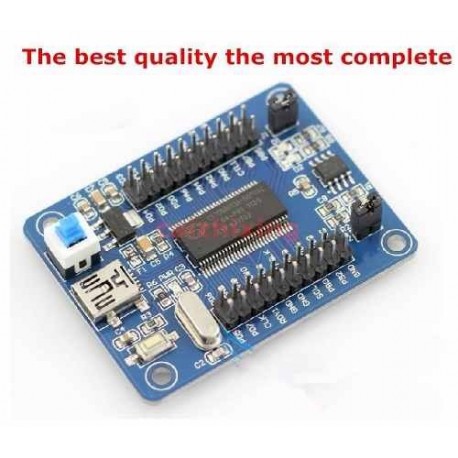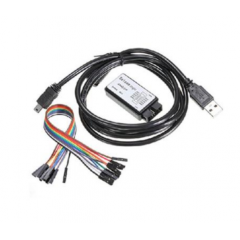Analizador Logico Iez Ez-usb Fx2lp Cy7c68013a Itytarg
MLA668630163
Nuevo producto
Cod: GAW-IEZ
7 artículos
Más
IEZ-USB FX2LP CY7C68013A USB core board development board USB logic analyzer I2C serial and SPI high quality In stock
Features
1, using CY7C68013A-56 chip: low-power version of the enhanced 51-core, 16KB program data areas, frequency of 48Mhz, 480Mbps high-speed transmission protocol standards, in line with USB2.0 specification, backward compatible with USB1.1.
2, firmware, EEPROM: Complete in-system programming solution with a USB cable directly to download firmware, on-board to provide 16K (24LC128) a large program memory (EEPROM), used as storage VID / PID and the USB firmware, the program space to meet the CY7C68013A needs.
3, all the GPIO pin through the 2.54mm standard leads to very convenient for learners to expand their own design.
4, with the appropriate board firmware can be achieved through the core function of the logic analyzer
Cypress’s EZ-USB® FX2LP™ (CY7C68013A/14/15/16A) is a low power, highly integrated USB 2.0 microcontroller.
This chip is a General Programmable Interface (GPIF™) that is supposed to ease the development of USB devices such as keyboards, mouses (mice!), flash drives, etc.
The board that I ordered is a development board from AliExpress for $4.60 and I was really impressed with its quality.
There are 2 variants, one with one jumper & another with 2 jumpers. Both comes with a on/off switch and a RESET push button.
The board also has an EEPROM (ATMEL 24C128 on my board) which is used to hold the VID/PID/DID of the device - this is for the host to identify the device to determine the correct driver.
My board was of the 2 jumper model & I think both are the same.
J1 is to connect/disconnect 2 LEDs from Vcc - these LEDs are connected to D0 & D1
J2 controls the high address bit of the EEPROM making it appear at I2C address 0xA0 or 0xA2 depending on the jumper.
The FX2LP is designed with a unique feature that allows the firmware to be loaded to the chip RAM either from the host or from the EEPROM.
Sigrok is a portable, cross-platform, Free/Libre/Open-Source signal analysis software suite.
It supports a variety of devices & boards (logic analyzers, oscilloscopes, digital multi-meters, ... etc.)
Sigrok GUI frontend is called PulseView and this is application that we'll be using.
To have the board working with PulseView we need the correct Windows driver - I downloaded it from here.
The driver will be recognized as: Cypress FX2LP No EEPROM Device.
This driver is probably not going to work with PulseView & we have to install a generic Windows USB driver using Zadig, which is an application that is installed with PulseView.
After installing the Cypress driver, run Zadig & from the Options menu make sure that "List all drivers" is checked.
Select the Cypress driver & press the button.
It may take a long time to install but eventually it will finish.
Now PulseView should be able to detect & use the board.
I used an Arduino as a simple 5-bit binary counter & monitor the output pins 8 to 12.
Connect the GND of the Arduino to GND of the FX2LP.
Connect pin 8 of the Arduino to PB0 of the FX2LP, pin 9 to PB1, pin 10 to PB2, pin 11 to PB3 & pin 12 to PB4
The code i very simple:
void setup() { Serial.begin(9600); DDRB = B11111; }
int i=0;
void loop() { Serial.println(i,HEX); PORTB = i ; i++; i&=0x1f; }
Setting the number of samples to 2M sample/second & the sampling rate to 1MHz will give us 2 seconds of sampled data










